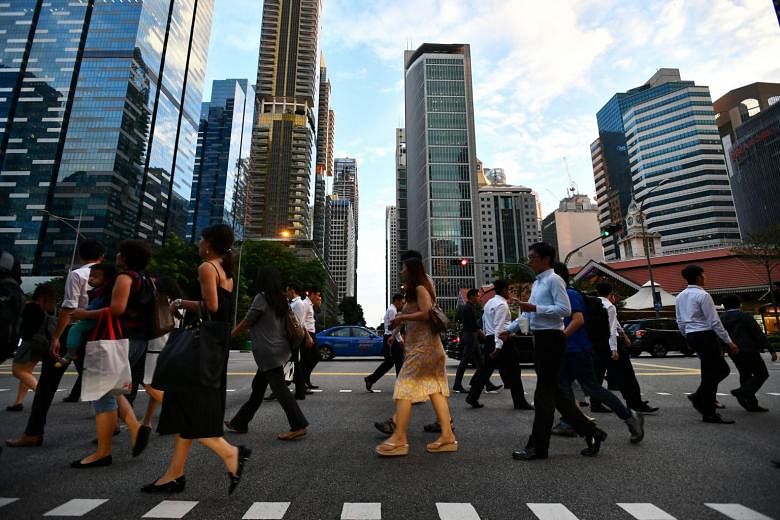SINGAPORE - Singapore's labour market was on the mend in the first half of this year.
The unemployment rate as well as the long-term unemployment rate for residents fell slightly from March to June, figures released on Thursday (Sept 14) show.
By June 2017, 4,000 more Singaporean and permanent resident workers were employed than at the end of last year - the first time in three years that local employment grew during those months, the Manpower Ministry (MOM) said in a statement.
The seasonally adjusted unemployment rate for Singaporeans was 3.3 per cent in June, down from 3.5 per cent in March, while the rate for Singaporeans and permanent residents combined was 3.1 per cent, down from 3.2 per cent in March.
The overall rate remained unchanged at 2.2 per cent, and the rates were still higher than they were a year ago.
Long-term unemployment, which measures the group who remain jobless for 25 weeks or more as a proportion of the labour force, declined slightly to 0.7 per cent in June, from 0.8 per cent in March, according to preliminary figures that took into account seasonal variations. This figure stood at 0.7 per cent in June 2016 as well.

"The resident unemployment and long-term unemployment rates could remain elevated in the medium term with ongoing economic restructuring, as well as shifts in the composition of the resident labour force and job-skills mismatch," said the ministry.
The pickup in local employment growth in the first half of the year was mostly in three sectors: community, social and personal services; finance and insurance services; and information and communication.
But it was offset by a fall of 21,400 in the number of foreigners employed, excluding maids. The bulk of those who left were work permit holders from the marine and offshore engineering and construction sectors, but it was also the first time since the first half of 2013 that the number of Employment Pass holders fell, with 2,400 fewer employed in June than at the end of last year, said MOM.
Total employment sat at 3,659,000 as at June.
Companies were able to do more with their workers, though, with labour productivity rising by 2.8 per cent in the first half of the year, compared with the same period last year. This was better than the 0.6 per cent growth in the first half of 2016, and 1.3 per cent in the second half. Sectors which did well included manufacturing, transportation and storage, and wholesale and retail trade, said MOM.
This augers well for businesses and workers, National Trades Union Congress (NTUC) assistant secretary-general Patrick Tay said in a Facebook post, adding that he hoped to see employers share the rewards with their staff.
From official figures for the second quarter of the year, which MOM also released on Thursday, 3,640 workers were laid off between April and June this year, an improvement from the first quarter (4,000) and from a year ago (4,800).
Three in four of those who lost their jobs were professionals, managers, executives and technicians (PMETs).
Meanwhile, 64.5 per cent of residents who were retrenched in the fourth quarter of last year were back in jobs in the second quarter this year. Older workers aged 50 and above, and PMETs, continued to fare less well, with re-entry rates of 52 per cent for older workers aged 50 and above, and 62 per cent for PMETs.
There was also good news for jobseekers: There were slightly more job openings to go around, with 49,000 vacancies in June, up from 46,800 in March, after accounting for seasonal variations.
This brought the seasonally adjusted ratio of job vacancies to unemployed people up to 0.85 in June, up from 0.81 in March and a low of 0.77 in December last year.
The ministry said companies will likely hire more workers in the second half of the year to cope with seasonal demand and slightly better economic growth, though the hiring outlook is uneven in manufacturing and lacklustre in construction. For services, outward-oriented sectors like finance and insurance and transportation and storage should see employment growth as the global economy recovers, while domestically oriented sectors will likely see stable hiring growth.
NTUC's Mr Tay said his Future Jobs, Skills and Training unit forecasts that opportunities will open up in the financial sector, infocomm technology, healthcare, wholesale trade as well as engineering-manufacturing, a field which includes aerospace, precision engineering, energy and chemicals and electronics.
MOM said the labour supply will remain tight in the medium term, with average annual employment growth of 25,000 to 40,000 expected over the next three to five years, excluding maids. "Local workforce growth will remain modest due to underlying demographic trends, while foreign workforce growth will continue to be moderated."


